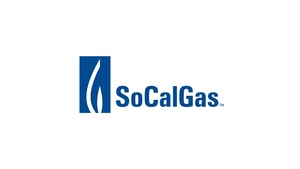New Economy-Wide Decarbonization Analysis Details Key Role of Clean Fuels Network in Achieving California's 2045 Climate Goals
- Building on previous state and industry studies, new research evaluates potential pathways to reach 100% carbon neutrality in California by 2045
- Analysis demonstrates how a clean fuels network supports decarbonization and electrification
- Findings outline the role existing natural gas infrastructure can play in advancing clean fuels adoption and achieving the most cost-effective, resilient, and lowest risk pathway to carbon neutrality
LOS ANGELES, Oct. 26, 2021 /PRNewswire/ -- A new economy-wide technical analysis released today by Southern California Gas Co. (SoCalGas) underscores the essential role that clean fuels like hydrogen and renewable natural gas (RNG) will play in a carbon-neutral California. SoCalGas' The Role of Clean Fuels and Gas Infrastructure in Achieving California's Net Zero Climate Goal examines the complexity of reaching 100% net zero emissions in California by 2045, and for the first time offers detailed solutions that include the clean fuels1 infrastructure needed to support and accelerate decarbonization efforts. The analysis also offers solutions for the hard-to-abate transportation and industrial sectors and supports existing state climate and energy policies, including resilient and reliable electrification.
"Climate change and the imperative to reduce and eliminate greenhouse gas emissions are driving a transformation of our nation's entire energy system," said SoCalGas President Maryam Brown. "Across the United States, electric and gas utilities are re-envisioning how they deliver the energy Americans need. SoCalGas, having set the goal to achieve net zero carbon emissions in everything we do by 2045, is leading the effort in California to accelerate a more equitable and affordable energy transition and to help establish Los Angeles as North America's first clean fuels hub."
Key Findings and Analysis
SoCalGas' technical analysis highlights that a clean fuels network made, in part, by leveraging existing gas infrastructure to deliver clean fuels and to manage carbon can allow California to achieve its net zero goals more affordably and with less risk than pursuing other pathways.
Key takeaways from the new technical analysis include:
- Electrification combined with clean fuels, carbon management, and technologies like fuel cells deliver the most affordable, resilient, and technologically proven path to full carbon neutrality.
- California, by leveraging the gas system to deliver clean fuels and to manage carbon, can reach 100% net zero goals more affordably, more equitably, and with less risk of power disruptions, customer conversion barriers, and technological limitations.
- Rapidly scaling up clean fuels initiatives today is vital to putting a clean fuels network in place in time to help California meet its climate goals. The faster stakeholders can collaboratively act to expand and accelerate clean fuels initiatives, the quicker California can decarbonize.
The technical analysis supporting The Role of Clean Fuels and Gas Infrastructure in Achieving California's Net Zero Climate Goal builds on existing climate models used in similar studies previously commissioned by the California Air Resources Board and the California Energy Commission. In addition, the modeling work and results of the technical analysis released today were independently verified by scientists at leading research institutions.
"Clean fuels, including green hydrogen, have an important role to play as California transforms to a carbon neutral economy over the next 20 years," said Jack Brouwer, director of the National Fuel Cell Research Center and Advanced Power and Energy Program at the University of California, Irvine. "As this analysis shows, a clean fuels network that carries decarbonized gas provides important features of lower cost, massive and long-duration storage, and resiliency that Californians demand."
"Solving the carbon neutrality puzzle will take the work of many collaborators and numerous technologies to provide resilient, reliable and decarbonized energy, economy-wide," said Lew Fulton, Director of the Sustainable Transportation Energy Pathways Program, of the Institute for Transportation Studies at University of California Davis. "SoCalGas' in-depth analysis, building on previous studies, shows it can be done, with the development of a clean fuels network."
"Carbon neutrality goals, whether local, regional or national, cannot be achieved without accounting for ways to decarbonize hard-to-abate sectors of the economy," said Erin M. Blanton, senior research scholar at the Center on Global Energy Policy at Columbia University's School of International and Public Affairs. "This analysis shows there is a way to achieve these goals, utilizing California's vast, existing, natural gas infrastructure."
SoCalGas' technical analysis demonstrates that a clean fuels network helps support the most cost-effective, resilient, and lowest risk pathway to full carbon neutrality by:
- Supporting electricity decarbonization: As more solar and wind are integrated onto the grid, and as more end uses are electrified, a clean fuels network supports the reliability of the electric grid by providing indispensable, flexible, and dispatchable power at times when renewables are intermittent.
- Providing decarbonized energy for hard-to-abate sectors: clean fuels will be essential to decarbonizing hard-to-abate sectors of the economy like heavy-duty transportation and industrial activities, which currently account for ~20% of California's greenhouse gas emissions.
- Lowering risk through diversification: The analysis shows a diverse set of decarbonization levers reduces the risk of over-dependence on any one technology.
- Delivering a more affordable and equitable transition: The modeling reveals a clean fuels network is worth between ~$45-$75 billion in savings in transition costs compared to full, economy-wide decarbonization in 2045 with a no fuels network.
SoCalGas Clean Fuel Initiatives
SoCalGas is actively engaged in more than 10 pilot projects related to hydrogen and has partnered with the Green Hydrogen Coalition, Los Angeles Department of Water and Power (LADWP) and other key partners, on HyDeal LA, an initiative to achieve at-scale green hydrogen procurement at $1.50/kilogram in the Los Angeles Basin by 2030.
SoCalGas is also testing and demonstrating transporting hydrogen using existing infrastructure and is collaborating with California's other gas utilities and with research institutions to develop a hydrogen blending standard for regulatory review.
Aspire 2045
Earlier this year, in support of California's climate goals, SoCalGas became the largest gas distribution utility in North America to set a net zero emissions goal that includes scopes 1, 2, and 3 GHG emissions. SoCalGas' Aspire 2045 strategy aligns with the recommendations of the Paris Climate Agreement and reflects the company's focus on supporting California with a resilient gas grid through the energy transition to support a carbon neutral economy.
To read SoCalGas' The Role of Clean Fuels and Gas Infrastructure in Achieving California's Net Zero Climate Goal, visit socalgas.com/cleanfuels.
About SoCalGas
Headquartered in Los Angeles, SoCalGas® is the largest gas distribution utility in the United States. SoCalGas delivers affordable, reliable, and increasingly renewable gas service to 21.8 million consumers across 24,000 square miles of Central and Southern California. Gas delivered through the company's approximately 50,000 miles of service pipelines will continue to play a key role in California's clean energy transition—providing electric grid reliability and supporting wind and solar energy deployment.
SoCalGas' mission is to build the cleanest, safest and most innovative energy company in America. In support of that mission, SoCalGas is committed to the goal of achieving net-zero greenhouse gas emissions in its operations and delivery of energy by 2045 and to replacing 20 percent of its traditional natural gas supply to core customers with renewable natural gas (RNG) by 2030. Renewable natural gas is made from waste created by dairy farms, landfills, and wastewater treatment plants. SoCalGas is also committed to investing in its gas delivery infrastructure while keeping bills affordable for customers. SoCalGas is a subsidiary of Sempra (NYSE: SRE), an energy services holding company based in San Diego. For more information visit socalgas.com/newsroom or connect with SoCalGas on Twitter (@SoCalGas), Instagram (@SoCalGas) and Facebook.
This press release contains statements that constitute forward-looking statements within the meaning of the Private Securities Litigation Reform Act of 1995. Forward-looking statements are based on assumptions with respect to the future, involve risks and uncertainties, and are not guarantees. Future results may differ materially from those expressed in any forward-looking statements. These forward-looking statements represent our estimates and assumptions only as of the date of this press release. We assume no obligation to update or revise any forward-looking statement as a result of new information, future events or other factors. In this press release, forward-looking statements can be identified by words such as "believes," "expects," "anticipates," "plans," "estimates," "projects," "forecasts," "should," "could," "would," "will," "confident," "may," "can," "potential," "possible," "proposed," "in process," "under construction," "in development," "target," "outlook," "maintain," "continue," "goal," "aim," "commit," or similar expressions, or when we discuss our guidance, priorities, strategy, goals, vision, mission, opportunities, projections, intentions or expectations. Factors, among others, that could cause actual results and events to differ materially from those described in any forward-looking statements include risks and uncertainties relating to: decisions, investigations, regulations, issuances or revocations of permits and other authorizations, renewals of franchises, and other actions by (i) the California Public Utilities Commission (CPUC), U.S. Department of Energy, and other regulatory and governmental bodies and (ii) states, counties, cities and other jurisdictions in the U.S. in which we do business; the success of business development efforts and construction projects, including risks in (i) completing construction projects or other transactions on schedule and budget, (ii) the ability to realize anticipated benefits from any of these efforts if completed, and (iii) obtaining the consent of partners or other third parties; the resolution of civil and criminal litigation, regulatory inquiries, investigations and proceedings, and arbitrations, including, among others, those related to the natural gas leak at the Aliso Canyon natural gas storage facility; actions by credit rating agencies to downgrade our credit ratings or to place those ratings on negative outlook and our ability to borrow on favorable terms and meet our substantial debt service obligations; actions to reduce or eliminate reliance on natural gas, including any deterioration of or increased uncertainty in the political or regulatory environment for local natural gas distribution companies operating in California; weather, natural disasters, pandemics, accidents, equipment failures, explosions, acts of terrorism, information system outages or other events that disrupt our operations, damage our facilities and systems, cause the release of harmful materials, cause fires or subject us to liability for property damage or personal injuries, fines and penalties, some of which may not be covered by insurance, may be disputed by insurers or may otherwise not be recoverable through regulatory mechanisms or may impact our ability to obtain satisfactory levels of affordable insurance; the availability of natural gas and natural gas storage capacity, including disruptions caused by limitations on the withdrawal of natural gas from storage facilities; the impact of the COVID-19 pandemic on capital projects, regulatory approvals and the execution of our operations; cybersecurity threats to the storage and pipeline infrastructure, information and systems used to operate our businesses, and confidentiality of our proprietary information and personal information of our customers and employees, including ransomware attacks on our systems and the systems of third-party vendors and other parties with which we conduct business; volatility in inflation and interest rates and commodity prices and our ability to effectively hedge these risks; changes in tax and trade policies, laws and regulations, including tariffs and revisions to international trade agreements that may increase our costs, reduce our competitiveness, or impair our ability to resolve trade disputes; and other uncertainties, some of which may be difficult to predict and are beyond our control. These risks and uncertainties are further discussed in the reports that the company has filed with the U.S. Securities and Exchange Commission (SEC). These reports are available through the EDGAR system free-of-charge on the SEC's website, www.sec.gov, and on Sempra's website, www.sempra.com. Investors should not rely unduly on any forward-looking statements.
1 Clean fuels are gases like green hydrogen, renewable natural gas, syngas, and biofuels, the production and combustion of which can be carbon-neutral or even carbon-negative.
SOURCE Southern California Gas Company

Related Links
WANT YOUR COMPANY'S NEWS FEATURED ON PRNEWSWIRE.COM?
Newsrooms &
Influencers
Digital Media
Outlets
Journalists
Opted In





Share this article